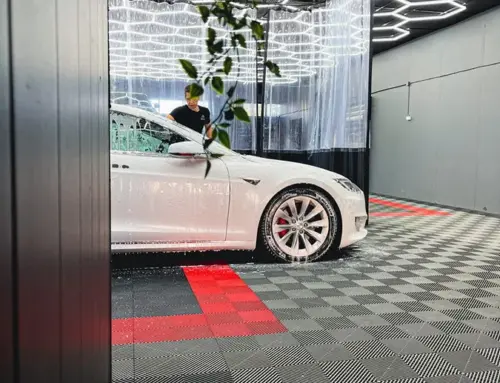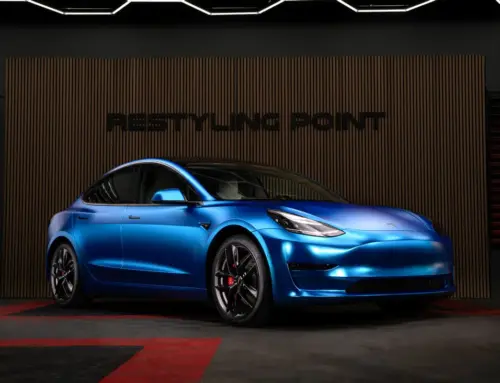Car paint surfaces get scratched and worn out with the use of the vehicle. This is something that is impossible to prevent. Even a slight touch on the paint surface causes scratches, and when this happens repeatedly, scratches accumulate, and the gloss of the paint surface diminishes.

Car paint polishing / buffing and waxing was invented as early as 1888. Menzerna developed the first polishing pads and waxes at that time. Over the years, polishing methods and equipment have been developed due to the differences in paint surfaces.
Polishing aims to remove scratches from the paint surface. In clear-coated cars, the clear coat is thinned until the scratch is reached, at which point the scratch is leveled. Light does not reflect properly from a scratched surface, resulting in diminished gloss. Light reflects properly from a smooth surface. Sometimes scratches have penetrated through the clear coat, making it impossible to remove them completely with polishing. While the scratches can be reduced, they cannot be entirely eliminated. Removing deep scratches is also risky. When the surface heats up and the clear coat thins, it’s possible to accidentally burn through the clear coat, leaving marks or even exposing the substrate. If this happens, repainting is the only option.
Polishing always starts with coarser methods and progresses to softer ones.
Before the development of dual-action polishers, cars were polished using rotary polishers. This is a highly effective method for removing scratches but also the easiest way to burn through the clear coat and leave holograms.
A dual-action polisher is the safest way to polish a car. The orbital motion doesn’t heat up the surface too much and often doesn’t leave significant holograms.
With a dual-action polisher, you can also perform a technique called “halo polishing”.

1-Step / Single-Stage Polishing:
In the 1-step polishing method, the paint surface is treated with a medium-hard polishing pad and a compound that does not contain many abrasives. This method removes oxidation and wear from the paint surface, but not many scratches. The goal is to polish the car without leaving any polishing marks. 1-step is ideal for polishing a new car or removing very light swirls.
2-Step / Two-Stage Polishing:
In this method, the car is polished twice. The first time, a much harder pad and a more aggressive compound are used. The first pass is also longer, and more effort is made to remove scratches. The method will inevitably leave polishing marks on the surface, which are then removed using a 1-step method with a soft pad and a less abrasive compound.
2-Step is a good option for cars with low mileage or cars that need to have things like insect stains removed from the front and mirrors. On soft-lacquered cars, a scratched car can be polished using only the 2-Step method. The first step removes deeper scratches, and the second step finishes the surface and removes micro-scratches left by the first step.

3-Step / Three-Stage Polishing:
3-step polishing is intended for cars with extensive scratches and those for which you want the best possible results. This polishing process starts with a very hard and coarse pad. The first step involves the most work and takes the most time. The surfaces are treated carefully and inspected in between. The work is demanding because the dual action polisher does not cut in the same way as a rotary polisher, for example, but the final result is much easier to achieve.
Once the first step is done and almost all scratches are removed, we move on to a slightly softer pad and compound. In this step, the surfaces are also treated for a long time and carefully, and we make sure that the marks from the first step are removed. In the last step, a very soft pad and finishing compound are used. This finishes the surface to be completely flawless and ensures that any polishing marks disappear.
3-step is a good way to save a car with extensive scratches. For example, black hard-lacquered cars always require 3-step polishing if you want an excellent result. With 3-step, it is possible to remove even deep scratches that have almost gone through the paint.
After polishing, the surface must always be protected. If you have a limited budget, wax can also be used for protection, but we always recommend ceramic coatings. This is by far the most durable solution for a freshly polished surface.

Car Polishing
In polishing, we always use different sized machines to reach tight spots. Modern times allow for the use of different machines, compounds, pads, and polishes, which makes the polishing process easier.
Polishing is 100% handwork and very precise work. Scratches may not be visible in different lights, and the use of lights is mandatory. Without lights, the surface may be left with unsightly polishing marks.
Polishing is the only way to remove scratches if you don’t want to have your car painted. Polishing is also considerably cheaper than painting.
Other parts of the car can also be polished. For example, the high-gloss black interior parts that are prone to scratching can often be saved by polishing. Not all scratches can be removed, but the shine can be brought back. These surfaces can also be protected with a ceramic coating or PPF film.
Wheels can also be polished. Modern, very small polishing machines can fit into small gaps and spaces. This is a good way to bring back the lost shine of the wheels. After polishing, it is a good idea to protect the wheels with a ceramic coating.

Even door gaps and exhaust pipes can be polished. There are hundreds of possibilities!
Take a look at your car’s paintwork in good light and you’ll notice that it’s not perfect. Bring your car to us for inspection, we’ll go through the surfaces and give you an estimate for the polishing costs. At the same time, we can discuss the benefits of ceramic coating or you can read more about it on our blog: Ceramic Coating – A Guide.
Do you want the work done responsibly, on schedule and with the best value for your money?
Ask for a quote from Restyling Point’s professionals, who do this with quality standards, values and love.
WhatsApp: +358445050624
Phone: +358445050624
By email: [email protected]
Restyling Point Oy – The Nordic leader in wrapping and protection treatments.











